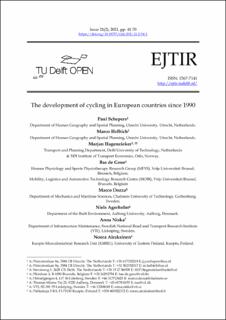| dc.contributor.author | Schepers, Paul | |
| dc.contributor.author | Helbich, Marco | |
| dc.contributor.author | Hagenzieker, Marjan Paula | |
| dc.contributor.author | de Geus, Bas | |
| dc.contributor.author | Dozza, Marco | |
| dc.contributor.author | Agerholm, Niels | |
| dc.contributor.author | Niska, Anna | |
| dc.contributor.author | Airaksinen, Noora | |
| dc.contributor.author | Papon, Francis | |
| dc.contributor.author | Gerike, Regine | |
| dc.contributor.author | Bjørnskau, Torkel | |
| dc.contributor.author | Aldred, Rachel | |
| dc.date.accessioned | 2023-06-19T14:33:38Z | |
| dc.date.available | 2023-06-19T14:33:38Z | |
| dc.date.created | 2021-11-09T10:16:03Z | |
| dc.date.issued | 2021-05-18 | |
| dc.identifier.citation | European Journal of Transport and Infrastructure Research. 2021, 21 (2), 41-70. | en_US |
| dc.identifier.issn | 1567-7133 | |
| dc.identifier.uri | https://hdl.handle.net/11250/3072101 | |
| dc.description | Schepers, P., Helbich, M., Hagenzieker, M., Geus, B. de, Dozza, M., Agerholm, N., Niska, A., Airaksinen, N., Papon, F., Gerike, R., Bjørnskau, T., & Aldred, R. (2021). The development of cycling in European countries since 1990. European Journal of Transport and Infrastructure Research, 21(2), 41–70. https://doi.org/10.18757/ejtir.2021.21.2.5411 | en_US |
| dc.description.abstract | High pre-World-War-2 modal shares of cycling in European countries sharply decreased during the post-war decades. In the 1990s, European governments introduced policies to increase bicycle use. However, a database or longitudinal study on the development of bicycle use in European countries is lacking. The goal of this paper is to examine to what degree the amount of cycling has increased over the past decades, also in thecontext of potentially competing modes. Distances travelled per capita according to National Travel Surveys have been collected and were aggregated to seven 4-year periods between 1990 and 2017. Multilevel regression analyses on distance travelled per capita by bicycle, on foot, by public transport, and by passenger car were conducted for all countries. Additionally, analyses were conducted for which the 14 countries with data on bicycle use were divided in three groups categorised according to distance cycled per capita at the beginning of the study period. Distance cycled per capita per year ranged from some 30 km to 900 km. The results of all four regression analyses suggested that distance cycled per capita remained fairly constant over the past decades. Germany is an exception with some 150 km per capita more, in relative terms a 50% increase. Geographical variation in development is evidenced by a substantial increase of distance cycled per inhabitant in the capital cities of the countries included in the study. The outcomes suggest distance travelled on foot and by public transport (bus, tram, and metro) also remained fairly constant while the distance travelled by car increased by about 10% during the study period. We did not find indications that cycling substitutes travel on foot, by public transport or by car. | en_US |
| dc.language.iso | eng | en_US |
| dc.publisher | Delft University Press | en_US |
| dc.rights | Navngivelse 4.0 Internasjonal | * |
| dc.rights.uri | http://creativecommons.org/licenses/by/4.0/deed.no | * |
| dc.subject | bicycle use | en_US |
| dc.subject | active transpor | en_US |
| dc.subject | sustainable transpor | en_US |
| dc.subject | National Travel Survey | en_US |
| dc.subject | Europe | en_US |
| dc.title | The development of cycling in european countries since 1990 | en_US |
| dc.type | Journal article | en_US |
| dc.type | Peer reviewed | en_US |
| dc.rights.holder | © 2021 Paul Schepers, Marco Helbich, Marjan Hagenzieker, Bas de Geus, Marco Dozza, Niels Agerholm, Anna Niska, Noora Airaksinen, Francis Papon, Regine Gerike, Torkel Bjørnskau, Rachel Aldred | en_US |
| dc.description.version | publishedVersion | en_US |
| cristin.ispublished | true | |
| cristin.fulltext | original | |
| cristin.qualitycode | 1 | |
| dc.identifier.doi | 10.18757/ejtir.2021.21.2.5411 | |
| dc.identifier.cristin | 1952646 | |
| dc.source.journal | European Journal of Transport and Infrastructure Research | en_US |
| dc.source.volume | 21 | en_US |
| dc.source.issue | 2 | en_US |
| dc.source.pagenumber | 41-70 | en_US |

